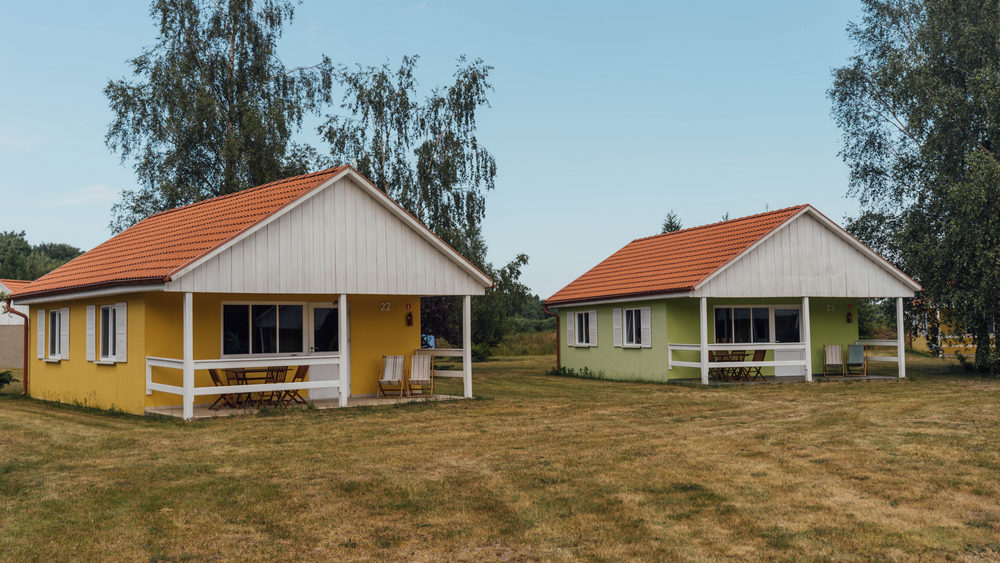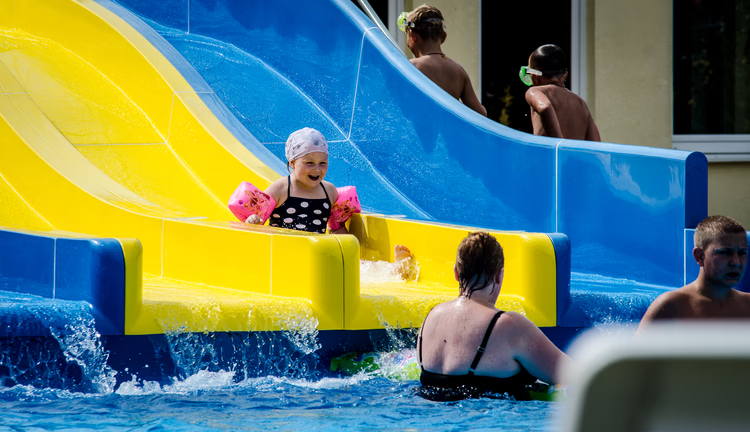The shifting dunes in Łeba can surprise you not only with their appearance, but also with their history. Long before you stood on the top of Łącka Dune and looked at the lake on one side and the sea on the other – a lot more happened here than you might expect. A retreating glacier, winds from the Baltic, and people, who set in motion what we admire today. Discover how the dunes in Łeba were formed, why they are still moving and what exactly makes this one of the most extraordinary places on the map of Poland.
Where did the tons of material that formed the dunes come from?
Before you ask how the dunes in Łeba were formed, it’s worth going back to the time when… they didn’t exist at all. The land in this part of Poland was then covered by a thick ice sheet – a massive, cold body of ice slowly moving forward and reshaping everything in its path. The Scandinavian ice sheet left behind not only a crushed landscape, but above all huge amounts of rock material, including sands brought here all the way from northern Europe. These sands became the foundation of what you can see today on the trails of the Słowiński National Park.
As the climate started to warm, the glacier gradually retreated. It left behind vast, flat areas – so-called sandur plains, which were later flooded by the sea. The water did its job: it deposited fine material, and where it retreated, it left ideal conditions for dunes to form. All of this took place over thousands of years – slowly, but continuously. Subsequent transgressions of the Littorina Sea brought fresh sand, which was then “arranged” by the wind into what we now call dunes.
If you want to grasp the scale of this and stand where a single grain of sand can be several thousand years old, have a look at our article on what to see in Łeba. And if you prefer to stay closer to these natural wonders, you can choose one of our holiday cottages in Kacze Stawy, which are a perfect base for a trip to the dunes!

Winds that shape the landscape – how do dunes form from scratch?
How do shifting dunes form? “The wind” – that’s the answer, but only part of it. The wind is the tool, but it needs something to work with. Dunes are formed when sufficiently fine sand – not too heavy, not too light – is lifted from the beach and carried inland. It starts with deflation, which is the blowing away of the lightest particles. Then comes transport – the wind carries grains of sand for several, a dozen or even several dozen metres.
Only when they encounter an obstacle – for example a clump of plants, a piece of wood or a taller ridge – does accumulation occur, meaning the sand starts to settle. Step by step, a dune is built up. What looks today like a finished landscape is in reality constant motion, shifting and reshaping.
Interestingly, the dunes “move” mostly in the autumn and winter season, when the wind is strongest and the surface is driest. That’s when everything speeds up. Łącka Dune, the highest in the area, moves by as much as 10 metres a year. What’s more – some dunes are already encroaching on Lake Łebsko, reducing its surface. This is why the landscape here feels so alive and ever-changing.
If you want to experience this for yourself, make sure you read how long it takes to walk along the beach from Łeba to the dunes – we’ll tell you everything you should know before you lace up your shoes. With that knowledge, the walk takes on a completely new meaning.
Why without grasses there would be no shifting dunes in Łeba – about psammophytes no one notices
When you look at the dunes in Łeba, it may seem that this is a landscape ruled only by wind and sand. And yes – these two factors are crucial. But without one more element, it would be impossible to keep everything under control. We’re talking about plants, and specifically so-called psammophilous species – plants that are made to live in sand. Lyme grass, sand sedge or marram grass may not sound very spectacular, but they are exactly what holds the sand in place and allows stable dunes to develop.
You won’t see these plants in forests, nor in city parks. They are specialists – adapted to living in extreme conditions, where the ground changes every day and the wind can blow away entire stretches of surface. Dune vegetation grows low, develops extensive root systems and… acts like a natural filter for sand. It traps it, collects it and then allows it to accumulate, building ever higher landforms.
It’s thanks to this vegetation that the dunes in Łeba not only form, but can also survive. Without it, the wind would simply blow everything away in different directions. If you’re planning a walk in the area, keep this in mind and first read our guide on what to do in Łeba – you’ll find ideas for holidays that go far beyond just sitting behind a windbreak. With this knowledge, even a simple stroll gains a whole new meaning.

The spit that separated sea from lake – a natural stage for a shifting spectacle
To understand how the dunes in Łeba were formed, you need to take a look at the map. Because without the spit – nothing would have happened. The Łeba Spit is a strip of land separating the Baltic Sea from Lake Łebsko, created as a result of a series of transgressions of the Littorina Sea. It is here – between water and water – that nature set up the perfect conditions for dunes to develop. This area was constantly flooded and dried out, which led to sand being deposited and created a space where the wind could fully show its strength.
Over thousands of years, the wind blew successive layers of material from the beaches onto the spit. With time, the first landforms appeared – initially forested, and gradually more and more barren and mobile. The spit not only created a physical barrier between the two bodies of water, but also became a key geological stage, where to this day the spectacle of erosion, transport and accumulation of sand continues.
If you want to see this up close, the easiest way is to set off from the cottages at Kacze Stawy – located at a safe distance, yet perfectly situated for trips in the area.
How did the dunes in Łeba form? From people to disaster – how deforestation set a wave of sand in motion
Although the shifting dunes near Łeba are mainly associated with the forces of nature, their most dynamic phase started… because of people. In the 14th and 15th centuries, as ports and settlements grew, intensive deforestation began. People needed wood – for fuel, for construction, for export. Once the vegetation cover was removed, nothing held the sand in place anymore. The wind, which had previously been stopped by natural barriers, now had a clear path.
What happened next can hardly be called anything other than a disaster. The dunes started to move, burying more and more land. One event in particular had tragic consequences – a storm in 1558 that lasted several days and led to parts of the town being completely buried. Old Łeba ceased to exist – it had to be rebuilt in a new location. Today this is often mentioned as a turning point when people realised that sand is not something to underestimate.
From that moment onwards, the Łeba dunes entered a phase of active migration – a phase that continues to this day. Although their movement is now monitored and the area is protected, history clearly shows how easily human interference can trigger a powerful natural mechanism.
White, grey, brown – how the dune types differ and what they say about history
The dunes in Łeba are not just a single type of landform. Although to the naked eye they may look quite similar – like waves of sand – geologists can easily distinguish three clear types. Each one tells a different story about this place.
- White dunes are the youngest forms – almost entirely devoid of vegetation, shifting and highly active. The sand here is bright, sometimes almost white, and its movement can be seen even during a single season. These are the dunes you usually photograph when visiting the park.
- Just behind them – sometimes literally – lie the grey dunes, partly stabilised by pioneer vegetation. You can already see not only sand, but also low sandy grasslands and moss. The grey colour is the result of humus – the remains of the first lichens and plants that are trying to hold the sand in place. These landforms move much more slowly, but they are still “in the game”.
- The oldest are the brown dunes – completely stabilised, covered with forest and with fully developed soil. When you walk through the pine forest around Łeba, there’s a good chance you are actually walking on an old dune. These forms tell the story of the time when sand became part of a stable ecosystem. It is here that geologists find traces of old soils, charred remains of wood and other evidence of past human activity.

A moving force of nature – how exactly do the Łeba dunes “wander”?
What fascinates most is the fact that the dunes don’t stand still. They genuinely move. Even though they do so slowly – a few metres a year – this movement never stops. Łącka Dune, the biggest in the region, shifts by up to 10 metres eastwards each year. But what does this process actually look like?
First, the wind blows sand up the gentle slope known as the windward side. The grains climb it until they reach the crest. Then, on the other side – the leeward slope – the sand literally avalanches down, building another portion of the dune. The whole mass of sand essentially takes a kind of “step” – and this repeats every season. Over time the dune begins to engulf everything in its path: plants, trees, and even… fragments of old buildings.
Interestingly, this process isn’t uniform. Some dunes move faster, others barely at all – it all depends on ground moisture, wind strength and the lack of vegetation. The biggest shifts take place in winter and autumn, when strong storm winds arrive over the Baltic.
See the dunes in Łeba with your own eyes!
Protecting nature from ourselves – how people are now trying to manage what they once unleashed
Today we know one thing – the shifting dunes near Łeba should not be “tamed” by force. They are part of nature that must follow its own rhythm. At the same time, however, we have to make sure we don’t destroy what is so unique. That’s why the dunes are protected within Słowiński National Park. You can’t enter the shifting dune area with a dog, leave the marked trail or pick plants there – and that’s exactly how it should be.
Modern protection means not only bans, but also monitoring the pace of dune migration, studying vegetation, controlling tourist pressure and working to protect bird habitats and unique lichen species. The idea is not to stop the process, but not to disturb it either. The balance here is very delicate – and that is exactly why this part of the coast has been recognised as one of the most valuable natural areas in Europe. If you’re planning a visit, consider staying in one of our seaside rooms at Kacze Stawy – away from city noise, but close enough to easily reach the dunes on foot, by bike or by bus. This way you can admire the forces of nature up close, without disturbing their fragile rhythm.






